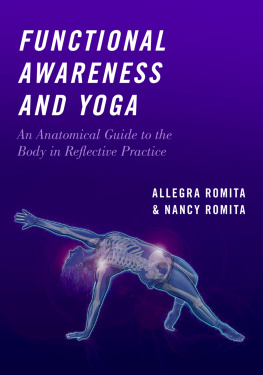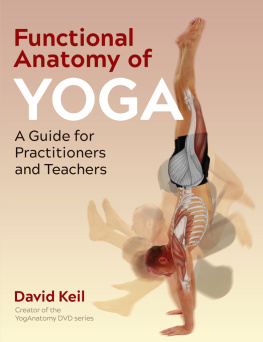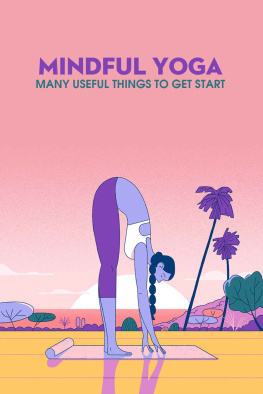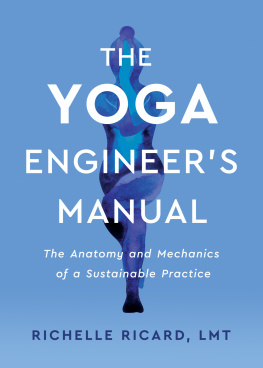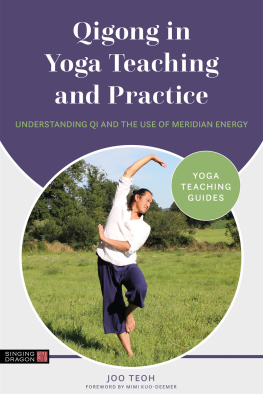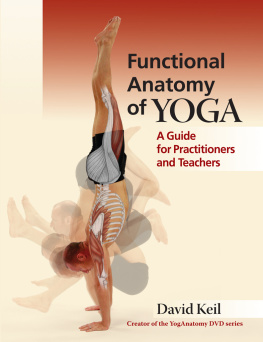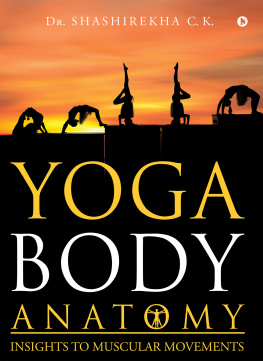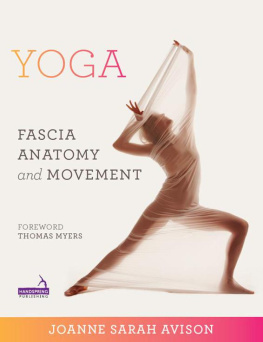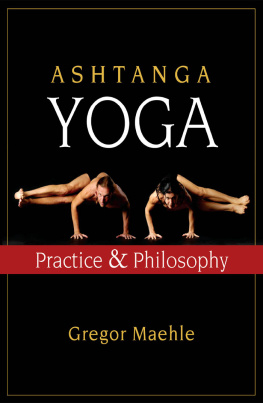Contents
Pagebreaks of the print version
Functional Awareness and Yoga

Oxford University Press is a department of the University of Oxford. It furthers the Universitys objective of excellence in research, scholarship, and education by publishing worldwide. Oxford is a registered trade mark of Oxford University Press in the UK and certain other countries.
Published in the United States of America by Oxford University Press
198 Madison Avenue, New York, NY 10016, United States of America.
Oxford University Press 2019
All rights reserved. No part of this publication may be reproduced, stored in a retrieval system, or transmitted, in any form or by any means, without the prior permission in writing of Oxford University Press, or as expressly permitted by law, by license, or under terms agreed with the appropriate reproduction rights organization. Inquiries concerning reproduction outside the scope of the above should be sent to the Rights Department, Oxford University Press, at the address above.
You must not circulate this work in any other form
and you must impose this same condition on any acquirer.
Library of Congress Cataloging-in-Publication Data
Names: Romita, Allegra, author. | Romita, Nancy, author.
Title: Functional awareness & yoga : an anatomical guide to the body in reflective practice / Allegra Romita & Nancy Romita
Other titles: Functional awareness and yoga
Description: New York, NY : Oxford University Press, [2019] | Includes bibliographical references and index.
Identifiers: LCCN 2018011713 (print) | LCCN 2018032478 (ebook) | ISBN 9780190863937 (updf) | ISBN 9780190863944 (epub) | ISBN 9780190863937 (updf) | ISBN 9780190863944 (epub) | ISBN 9780190863913 (cloth : alk. paper) | ISBN 9780190863920 (pbk. : alk. paper)
Subjects: LCSH: YogaPhysiological aspects. | Mind and body. | Muscular sense.
Classification: LCC RC1220.Y64 (ebook) | LCC RC1220.Y64 R66 2019 (print) | DDC 613.7/046dc23
LC record available at https://lccn.loc.gov/2018011713
Contents
We wish to pay homage to our somatic and embodied anatomy teachers, guides, and predecessors. It is by no means a complete list, but it identifies key influences in our current research.
Allegra: I thank Sid McNairy, who guided me through my first 200-hour teacher training. I thank Amy Chavasse at the University of Michigan for our early journey with yoga, and opportunities to teach and train others. I continue to learn from and be inspired by Ossi Raveh and my yoga family at Brooklyn Yoga Project. I appreciate those who have influenced my understanding of embodied anatomy: Amy Matthews, Marika Molnar, Khita Whyatt, Ananda Apfelbaum, Cheryl Clark, and John Chanik. In addition, I am grateful to those who ignited my interest in movement education, writing, and curriculum design at New York University, particularly Dr. Susan Koff, Pat Cohen, and Deborah Damast. I acknowledge and honor Dr. Richard Magill for my growing understanding of motor learning, and for supporting my continued graduate studies at Columbia University.
I pay homage to my coauthor and mother. She is a thoughtful and supportive parent, business partner, artist, mentor, friend, and somatic teacher. This journey is not possible without her partnership and coauthorship.
Nancy: I owe gratitude to teacher/mentor Martha Myers and her visionary work in integrating somatic exploration with dance training at my alma mater, Connecticut College. In the 1970s, Martha introduced me to not only somatic practices, but also Bartenieff Fundamentals, Feldenkrais Method, Alexander Technique, and Dance Movement Therapy at the American Dance Festival. These early experiences in somatic education led me on a lifelong exploration to support others in discovering easeful use and integrated movement function and discovering balance in body, psyche, and spirit. In addition, I give profound thanks to the deep wisdom of Deborah Quirk and her many years as my yoga guide through the practice of Vinyasa yoga. I thank Sarah Ittman and Katie Thorworth for deepening my practice and encouraging my ability to teach and train others in the Vinyasa practice. I thank the American Center for the Alexander Technique for providing a pathway to the psychophysical philosophies and principles I embody and convey daily through the work of FM Alexander. Alexanders approach to the relationship between structure, function, and use deeply informs my work in both Functional Awareness and yoga.
Finally, I thank my coauthor, collaborator, colleague, and daughter, Allegra. I acknowledge the supreme patience and caring Allegra exhibited in introducing the principles and practice of yoga to me. I also appreciate Allegras inspiring and innovative thinking on the relationship of biomechanical function and the artistry and spirituality of movement.
In the collective professional experience of training people in somatic-based practices, we have had vast and varied influences on our work. After many years of applying functional movement theory into practice, it is hard to distinguish the original sources of many of the practices and stories implemented. This book contains a Bibliography to acknowledge the mentors, teachers, and literature that influenced this current path of integrated knowledge. If we are aware of the origin of a specific exploration or anatomical information, it is acknowledged and referenced.
We thank the many people who supported this project with the generous gift of their time and talents. We owe a supreme debt of gratitude to Norm Hirschy of Oxford University Press, whose encouragement and belief in our work sustains our courage to move thoughts from the yoga studio and the teaching classroom to the written page. We also thank Lauralee Yeary for her stewardship of the manuscript through the process at Oxford University Press. In addition we honor and thank Betsy Winship, our guide to editing and book publishing in the early stages of preparing the manuscript for submission.
We are grateful to Caitlin Hughes for her beautiful illustrations, displayed throughout the book. Caitlins artwork supports the context and philosophy of Functional Awareness and enlivens the content for the reader. We give thanks and heartfelt gratitude to Jim Burger for his artistic and photographic talents, which inspired our visioning for the illustrations of yoga poses during the early drafts of the book. We also thank Hollis McCracken for her pencil drawings.
In addition, we appreciate and thank Dr. Susan Kirchner for encouraging us to deepen the research in somatic principles as they relate to the practice of education and performance. We thank Ossi Raveh, Deborah Quirk, and Sara Ittman Leite for their support as readers and generously contributing their thoughts and feedback. We thank lululemon on Smith Street in Brooklyn, New York, for their continuing support of our work.
Finally, we thank Vic Romita, loving husband and father, for his undying enthusiasm and support for all artistic endeavors partaken.
Yoga is the practice of unifying body, breath, and mind. This spiritual, mental, and physical practice exists in many forms. Functional Awareness and Yoga enhances the practice of yoga and guides the reader through mental and physical explorations to develop an enhanced understanding of the body in action within the context of any yoga practice. Functional Awareness (FA) is an approach linking embodied anatomy and reflective practice to enhance ease in action during movement training; thus the book focuses on the physical, asana-based practice of yoga. Anyone who practices yoga and is interested in learning more about the body can find this information helpful. The book is not an anatomy text; rather, the book highlights specific content from functional anatomy to deepen the readers knowledge of his or her own body to promote resilience, as well as the balance between flexibility and strength.

